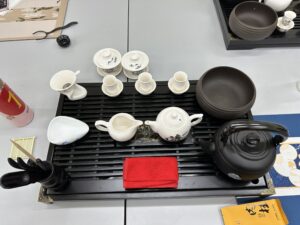Tea and Art: A Learning Suite for Experience, Reflection and Sharing.

Summary
This content takes tea art practice as the entry point, guiding learners to refocus on the composition methods of daily objects, actions and relationships through the processes of organizing, brewing and tasting tea. The arrangement of tea sets, the control of rhythm and the occurrence of interaction enable participants to realize that art is not only generated in the studio but is constantly constructed in daily behaviors. Through this experience, learners can understand how contemporary art is activated in the subtle changes of the body, space and perception, and recognize that creation is a continuous and relational process.
1.Introduction (1 minute)
This course takes tea art practice as the entry point, guiding learners to re-examine the composition of daily items, behaviors and relationships through the arrangement, brewing and tasting of tea sets. The arrangement of tea sets, the control of rhythm and the occurrence of interaction make participants realize that art is not merely produced in the studio, but is constantly constructed in daily behaviors. Through this experience, learners can understand how contemporary art is activated in the subtle changes of the body, space and perception, and recognize that creation is a continuous and relational process.
2.Required materials (1minute)
- Cover the tea tray or the table with a tea cloth.
- A gaiwan or teapot
- Several white porcelain tasting cups
- Tea strainer
- Tableware storage area (such as tissue boxes, simple tools)
- Environmental arrangement elements (such as vases, wooden cabinets and desktop decorations)

Preparation of tea set materials
3.Steps
Step 1: Create an atmosphere and attract attention (2–4 minutes)
Invite the participants to rearrange the tea sets on the table: gaiwan, tea cups, tea tray and tea towels.
The key to this stage lies in guiding them to observe the distance, orientation and rhythm between these items, making them realize that placement is both a spatial composition and a kind of “micro-curation”.
They are not merely “placing tea sets”, but rather creating a space that can accommodate such an experience.
Step 2: Enter the experience and action process (7–8 minutes)
Let the participants perform some simple tea ceremony actions, such as warming the cups, lifting the lids, pouring water and brewing tea.
This step does not emphasize techniques but focuses on “how actions generate perception”. They might notice the sounds (the clinking of porcelain), the temperature of the steam, the flow of tea water, or the rhythm of the movements.
At this point, daily movements gradually reveal a kind of “harmony between time and the body”, which naturally connects with contemporary art’s focus on the body and presence.
Step 3: Record and transform sensory experiences (3–4 minutes)
Please ask the participants to record the details they perceived during the process:
Sounds, watermarks, smells, hesitation or smooth movements.
These records can be in the form of text, photos, sketches or short audio clips.
Through documentation, experience is transformed from fleeting behaviors into reflective “artistic materials”, thereby connecting tea ceremony practice with artistic methodology.
Step 4: Share and establish new connections (2–3 minutes)
Finally, the participants shared their records and reflections and responded to different viewpoints.
In this kind of dialogue, the initial personal behavior is reinterpreted, thus generating new meanings and broader possibilities.
This process emphasizes the core of “relational aesthetics” in contemporary art:
Meaning does not exist in the object itself, but is produced through interaction.
4.Reflection and Summary(1minute)
The entire process reveals an important concept:
Contemporary art does not merely exist in the studio; it constantly emerges in everyday objects, movements and relationships.
Through the arrangement of tea sets, smooth movements and sensory perception, participants experienced how daily practice can become the entry point for understanding the relationship between art and themselves.
The tea art here is no longer merely about drinking tea; it is a way of thinking that uses the body, objects and space as media to help us rediscover the depth of perception and the possibilities of aesthetics in daily life.
(This work is licensed under CC BY-SA 4.0. To view a copy of this license, visit https://creativecommons.org/licenses/by-sa/4.0/)


